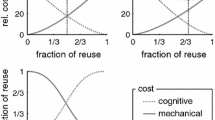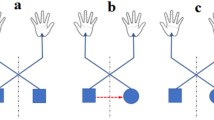Abstract
This report shows how a model initially developed for the control of reaching can be adapted for the control of handwriting. The main problem addressed by the model is how people can produce essentially the same written output with different effectors (e.g., the preferred or nonpreferred hand, the foot, or even the mouth). The model is based on the assumption that writers strive for invariant graphic outputs when they write with different effectors, when they write on surfaces with different orientations, or when they write large or small script; such output invariance is an essential requirement for later recognition of the written result. Given this assumption, the question is how the motor system enables the relevant effectors to generate the necessary pen strokes. The adapted model provides one possible answer to this question. It is the first fully working model of multijoint activity underlying writing and related graphic tasks. We describe how the model differs from other models developed in the past, and we review the model's strengths and weaknesses.
Similar content being viewed by others
References
Baxter, D. M., & Warrington, E. K. (1986). Ideational agraphia: A single case study. Journal of Neurology, Neurosurgery, and Psychiatry, 22, 369–375.
Berkenblit, M. B., & Feldman, A. G. (1988). Some problems of motor control. Journal of Motor Behavior, 20, 369–373.
Bernstein, N. (1967). The coordination and regulation of movements. London: Pergamon.
Bizzi, E., Hogan, N., Mussa-Ivaldi, F. A., & Giszter, S. (1992). Does the nervous system use equilibrium-point control to guide single and multiple joint movements? Behavioral and Brain Sciences, 15, 603–613.
Bullock, D., Grossberg, D., & Mannes, C. (1993). A neural network model for cursive script production. Biological Cybernetics, 70, 15–28.
Castiello, U., & Stelmach, G. E. (1993). Generalized representation of handwriting: Evidence of effector independence. Acta Psychologica, 82, 53–68.
Calis, G., Teulings, H. L., & Keuss, P. J. G. (1983). In search of writing and reading habits in the microgenetic phase of letter recognition. Acta Psychologica, 54, 313–326.
Cruse, H., Brüwer, M., & Dean, J. (1993). Control of three- and four-joint arm movement: Strategies for a manipulator with redundant degrees of freedom. Journal of Motor Behavior, 25, 131–139.
Denier van der Gon, J. J., & Thuring, J. Ph. (1965). The guiding of human writing movements. Kybernetik, 2, 145–148.
Edelman, S., & Flash, T. (1987). A model of handwriting. Biological Cybernetics, 57, 25–36.
Ellis, A.W. (1982). Spelling and writing (and reading and speaking). In A. W. Ellis (Ed.), Normality and pathology in cognitive functions (pp. 113–146). London: Academic Press.
Flash, T., & Hems, E. (1991). Arm trajectory modifications during reaching towards visual targets. Journal of Cognitive Neuroscience, 3, 220–230.
Flash, T., & Hogan, N. (1985). The coordination of arm movements: An experimentally confirmed mathematical model. Journal of Neuroscience, 7, 1688–1703.
Georgopoulos, A. P., & Grillner, S. (1989). Visuomotor coordination in reaching and locomotion. Science, 245, 1209–1210.
Guiard, Y. (1993). On Fitts' and Hooke's laws: Simple harmonic movement in upper limb cyclic aiming. Acta Psychologica, 82, 139–159.
Hasan, Z. (1991). Biomechanics and the study of multijoint movements. In D. R. Humphrey & H. J. Freund (Eds.), Motor control: Concepts and issues (pp. 75–84). Chichester: John Wiley & Sons.
Hogan, N., & Flash, T. (1987). Moving gracefully: quantitative theories of motor coordination. Trends in Neurol Science, 10, 170–174.
Hollerbach, J. M. (1981). An oscillation theory of handwriting. Biological Cybernetics, 39, 139–156.
Hollerbach, J. M. (1990). Fundamentals of motor behavior. In. D. N. Osherson, S. M. Kosslyn, & J. M. Hollerbach (Eds.), An invitation to cognitive science. Vol. 2: Visual cognition and action (pp. 153–182). Cambridge, MA: MIT Press.
Kagan, J. (1971). Change and continuity in infancy. New York: Wiley.
Keele, S. W., Cohen, A., & Ivry, R. (1990). Motor programs: Concepts and issues. In M. Jeannerod (Ed.), Attention and performance XIII: Motor representation and control (pp. 77–110). Hillsdale, NJ: Erlbaum.
Keele, S. W., Jennings, P., Jones, S., Caulton, D., & Cohen, A. (1995). On the modularity of sequence representation. Journal of Motor Behavior, 27, 17–30.
Kosslyn, S. M. (1980). Image and mind. Harvard: Cambridge University Press.
Lacquaniti, F., Terzuolo, C., & Viviani, P. (1983). The law relating kinematic and figural aspects of drawing movements. Acta Psychologica, 54, 115–130.
Lashley, K. S. (1942). The problem of cerebral organization in vision. Biological Symposia, 7, 301–322.
Merton, P. A. (1972). How we control the contraction of our muscles. Scientific American, 226, (May), 30–37.
Meulenbroek, R. G. J., & Van Galen, G. P. (1989). The production of connecting strokes: Developing co-articulation in 8 to 12-year old children. In R. Plamondon, C. Y. Suen, & M. L. Simner (Eds.), Computer recognition and human production of handwriting pp. 273–286). Singapore: World Scientific Press.
Meulenbroek, R. G. J., Rosenbaum, D. A., Thomassen, A. J. W. M., & Loukopoulos, L. D. (1994). A model of limb-segment coordination in drawing behaviour. In: C. Faure, P. Keuss, G. Lorette, & A. Vinter (Eds.), Advances in handwriting and drawing: A multidisciplinary approach (pp. 348–362). Paris: Europia.
Meulenbroek, R. G. J., Rosenbaum, D. A., Thomassen, A. J. W. M., & Schomaker, L. R. B. (1993). Limb-segment selection in drawing movements. Quarterly Journal of Experimental Psychology, 46A, 273–299.
Morasso, P., & Sanguineti, V. (1995). Self-organizing body scheme for motor planning. Journal of Motor Behavior, 27, 52–66.
Morasso, P., Mussa-Ivaldi, F. A., & Ruggiero, C. (1983). How a discontinuous mechanism can produce continuous movement in trajectory formation and handwriting. Acta Psychologica, 54, 83–98.
Mussa-Ivaldi, F. A., Morasso, P., & Zaccaria, R. (1988). Kinematic networks: A distributed model for representing and regularizing motor redundancy. Biological Cybernetics, 60, 1–16.
Pantina, N. S. (1957). Formitovanie dvigatel'nogo navyka pi'ma. Voprosy Psikhologii, 4.
Plamondon, R. (1993). Looking at handwriting from a velocity control perspective. Acta Psychologica, 82, 89–101.
Raibert, M. H. (1977). Motor control and learning by the statespace model. Technical Report AI-M-351, MIT.
Rosenbaum, D. A. (1991). Human motor control. San Diego: Academic Press.
Rosenbaum, D. A., Engelbrecht, S. E., Busche, M. M., & Loukopoulos, L. D. (1993). Knowledge model for selecting and producing reaching movements. Journal of Motor Behavior, 25, 217–227.
Rosenbaum, D. A., Loukopoulos, L. D., Meulenbroek, R. G. J., Vaughan, J., & Engelbrecht, S. E. (1995). Planning reaches by evaluating stored postures. Psychological Review, 102, 28–67.
Schneider, K., Zernicke, R. F., Schmidt, R. A., & Hart, T. J. (1989). Changes in limb dynamics during the practice of rapid arm movements. Journal of Biomechanics, 22, 805–817.
Schomaker, L., Thomassen, A. J. W. M., & Van Galen, G. P. (1986). A computational model of cursive handwriting. In. R. Plamondon, C. Y. Suen, & M. L. Simner (Eds.), Computer recognition and human production of handwriting (pp. 153–177). Singapore: World Scientific.
Schwartz, A. B. (1994). Direct cortical representation of drawing. Science, 265, 540–542.
Shadmehr, R. (1993). Control of equilibrium position and stiffness through postural modules. Journal of Motor Behavior, 25, 228–241.
Smyth, M. M. (1984). Memory for movements. In M. M. Smyth & A. M. Wing (Eds.), The psychology of human movement (pp. 83–117). London: Academic Press.
Soechting, J. F., & Lacquaniti, F. (1981). Invariant characteristics of a pointing movement in man. Journal of Neuroscience, 1, 710–720.
Swinnen, S. (1991). Motor control. In R. Dubelco (Ed.), Encyclopedia of Human Biology, Vol. V. San Diego: Academic Press.
Thomassen, A. J. W. M., & Teulings, H. L. (1983). The development of handwriting. In: M. Martlew (Ed.), The psychology of written language: Developmental and educational perspectives (pp. 179–213). New York: Wiley.
Van Galen, G. P. (1990). Phonological and motoric demands in handwriting: Evidence for discrete transmission of information. Acta Psychologica, 74, 259–275.
Van Galen, G. P., & Teulings, H. L. (1983). The independent monitoring of form and scale factors in handwriting. Acta Psychologica, 54, 9–22.
Van Galen, G. P. (1991). Handwriting: Issues for a psychomotor theory. Human Movement Science, 10, 165–191.
Vaughan, J., Rosenbaum, D. A., Moore, C., & Diedrich, F. (1996). Cooperative selection of movements: The Optimal Selection model. Psychological Research Psychologische Forschung, 58, 254–273
Viviani, P., & Stucchi, N. (1992). Biological movements look uniform: Evidence of motor-perceptual interactions. Journal of Experiment Psychology: Human Perception and Performance, 18, 603–623.
Vredenbregt, J., & Koster, W. G. (1971). Analysis and synthesis of handwriting, Philips Technical Review, 32, 73–78.
Warm, J. P., & Nimmo-Smith, I. (1990). Evidence against the relative invariance of timing in handwriting. Quarterly Journal of Experimental Psychology, 42A, 105–119.
Wright, C. E. (1990). Generalized motor programs: Reexamining claims of effector independence in writing. In M. Jeannerod (Ed.), Attention and performance XIII (pp. 294–320). Hillsdale, NJ, Lawrence Erlbaum.
Wright, C. E. (1993). Evaluating the special role of timing in the control of handwriting. Acta Psychologica, 82, 5–52.
Wright, C. E., & Lindemann, P. G. (1995). Generalization of motor representations for handwriting: What is learned when learning to write with the non-dominant hand? In M. Simner (Ed.), Proceedings of the Seventh biannial conference of the International Graphonomics Society (pp. 170–171). London, ON: University Press.
Author information
Authors and Affiliations
Corresponding author
Rights and permissions
About this article
Cite this article
Meulenbroek, R.G.J., Thomassen, A.J.W.K., Rosebaum, D.A. et al. Adaptation of a reaching model to handwriting: How different effectors can produce the same written output, and other results. Psychol. Res 59, 64–74 (1996). https://doi.org/10.1007/BF00419834
Received:
Accepted:
Issue Date:
DOI: https://doi.org/10.1007/BF00419834




